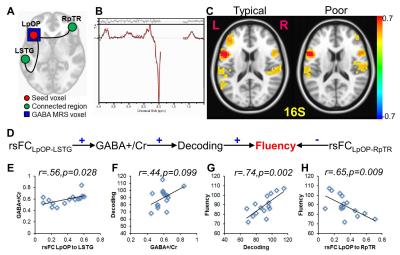Lisa C. Krishnamurthy1,2,3, Venkatagiri Krishnamurthy2,3,4, Dina M. Schwam5, Daphne Greenberg5, and Robin D. Morris3,6
1Dept. of Physics & Astronomy, Georgia State University, Atlanta, GA, United States, 2Center for Visual and Neurocognitive Rehabilitation, Atlanta VAMC, Decatur, GA, United States, 3Center for Advanced Brain Imaging, GSU/GT, Atlanta, GA, United States, 4Dept. of Neurology, Emory University, Atlanta, GA, United States, 5Dept. of Educational Psychology, Special Education, and Communication Disorders, Georgia State University, Atlanta, GA, United States, 6Dept. of Psychology, Georgia State University, Atlanta, GA, United States
Synopsis
Previous reports have shown that resting
concentrations of gamma-amino butyric acid (GABA) will predict resting state
Functional Connectivity (rsFC) measures as well as amplitude of
task activation. The goal of this study is to model how the
neurochemical profile interplays with the connectivity underlying the decoding
and fluency components of the reading circuit. Our model is in support of recent task-based fMRI observations,
but goes beyond by interrogating the underlying networks that support the
behavior, and combining that information with the neurochemistry that
characterize the trait. These preliminary results of combining MRS and rsFC
with neuropsychological measures are promising, and will help identify the
underlying dysfunction in struggling adult readers’ brain circuitry.
Purpose
Previous reports have shown that resting
concentrations of gamma-amino butyric acid (GABA) will predict resting state
Functional Connectivity (rsFC) measures1 as well as amplitude of
task activation2,3. Furthermore, the correlations quantified from
rsFC have been shown to covary with behavioral performance in the context of
the brain’s reading circuit4. The goal of this study is to model how
the neurochemical profile interplays with the connectivity underlying the decoding
and fluency components of the reading circuit.Methods
Subjects: Nine typical and six
adult struggling readers were recruited from the Center for the Study of Adult
Literacy, classified based on reading
assessments using the Woodcock-Johnson Test of Achievement-III. MRI/MRS acquisition:
High-resolution T1-weighted MPRAGE and rsfMRI (TR=2sec, TE=30ms,
voxel=3.4x3.4x4mm3, 32 slices) images were acquired on a Siemens 3T
Tim Trio with a 12 ch-head coil. Magnetic Resonance Spectroscopy (MRS) data was
collected using MEGA-PRESS, which applies a J-editing pulse to identify the
GABA metabolite (TR=2000ms, TE=68ms, edit pulse frequency=1.9ppm, control pulse
frequency=7.5ppm, VAPOR water suppression). The 3x3x3cm3 voxel was
placed in the Inferior Frontal Gyrus (IFG). An unsuppressed water spectrum from
the same area was also acquired for eddy current compensation. Processing of rsfCMRI: The rsFC
images were corrected for slice timing, global head motion, EPI distortions, physiological
noise, and spatially normalized to MNI, followed by masking of the ventricles,
low-pass filtering between 0.001 and 0.1Hz, and spatially smoothed (FWHM=6mm).
Seed-based CC analysis was applied in a whole-brain manner by seeding in Left
pars Opercularis (L-pOP), and transformed using a Fisher Z-transform. Processing of MRS: The MRS data was pre-processed with in-house
Matlab scripts to perform frequency and phase correction, align editing and
control spectra on the Creatine (Cr) peak, subtract editing and control spectra
to generate the difference spectrum, and 2Hz line broadening. The difference
and control spectra were separately fitted to a simulated basis set using
LCModel.Results
The fit of the GABA+ signal in the difference
spectrum was excellent (CRLB 3-8%; Fig1B). The rsFC measures were also of high
quality, such that they were sensitized predominantly to grey matter neuronal
activity. Seeding in L-pOP, we found significant connections with Left Superior
Temporal Gyrus (L-STG) in both typical and struggling readers (corrected
p<0.001, cluster size=100), but only detected significant connections to
Right pars Triangularis (R-pTR) in struggling readers (Fig1C). The rsFC
strength of L-pOP to L-STG is significantly and positively related to the
GABA+/Cr concentration in IFG (Fig1E). Furthermore, the amount of GABA+/Cr in
IFG is positively related with a subject’s ability to decode written language
(Fig1F). The ability to decode written language is directly and significantly
related to how fluently the subject is able to read (Fig1G), but is negatively
impacted by right hemisphere (RH) frontal connections (Fig1H). These results
culminate in the neurochemical-neurovascular-cognitive model shown in Fig1D,
where the left hemisphere (LH) connections in tandem with the neurochemical
profile promote reading fluency, whereas RH connections decrease fluency.Discussion and Conclusion
The LpOP to LSTG connection is known as the
dorsal path in the reading network, and has previously been linked to decoding
ability5. In task-fMRI studies, it has been suggested that some struggling
readers have a right-lateralized reading circuit, which is less efficient than
the typical left-lateralized reading network in typical subjects6. Our
model is in support of these observations, but goes beyond by interrogating the
underlying networks that support the behavior, and combining that information
with the neurochemistry that characterize the trait. These preliminary results of
combining MRS and rsFC with neuropsychological measures are promising, and will
help identify the underlying dysfunction in struggling adult readers’ brain
circuitry. Future work will explore the neurochemical profile in other related
brain regions of struggling readers, which will be combined with information
from whole brain rsFC.Acknowledgements
No acknowledgement found.References
[1]Kwan SH, et al. Neonatology 2014. [2]Hu Y, et
al. J Neurosci 2013. [3]Muthukumaraswamy SD, et al. Proc Natl Acad Sci USA
2009. [4] Hampson M, et al. Neuroimage 2006. [5] Pugh KR, et al. Ment Retard Dev
Disabil Res Rev 2000.[6] Waldie KE, et al. Brain Sci 2013.
